Del and Mladen review ‘Immortals’
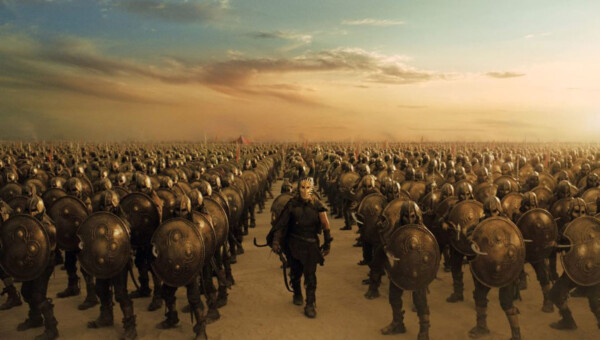
Image courtesy of Relativity Media.
—
“Immortals” Starring Henry Cavill, Mickey Rourke, Stephen Dorff, Freida Pinto, Luke Evans, John Hurt. Directed by Tarsem Singh. 110 minutes. Rated R.
Del’s take
OK, Mom and Dad. Do not – I repeat, do NOT – take the kiddies to see “Immortals.” If you do, I suggest when you get home you immediately hide the family sledgehammer. Yes, in “Immortals,” somebody does something very bad with a sledgehammer. We’re talking back-alley vasectomy. We wouldn’t want the kiddies getting any ideas.
You might also want to hide the kitchen knives, any random chains you’ve got hanging around, pikes, swords – heck, just hide everything. Or better, do NOT take the kiddies to see “Immortals.”
Because it’s a bloodbath – an empty, silly, thoroughly predictable yet exquisitely choreographed bloodbath. Take strawberries, tomatoes, cherry Jell-O, berry-flavored Kool-Aid, and dump them into a blender. Leave the top off and hit the “on” button. That’ll give you a visceral preview of “Immortals.” Oh, and you get to clean up the mess.
In “Immortals,” the gods have won their war against the Titans, imprisoning them within a mountain. But a power-mad human king, Hyperion (played with vicious gusto by Mickey Rourke) decides he must have a WMD, something called the Epirus Bow, with which he may free the Titans and rain destruction on all of Greece. The gods are bound by law not to interfere in the matters of men (probably a part of Obama’s health care plan), but Zeus (Luke Evans/John Hurt) has been secretly preparing a human peasant, Theseus (Henry Cavill), to lead the Greeks to triumph over Hyperion. When Hyperion’s men slay Theseus’ mother, and Theseus encounters a virgin vision-seer (Freida Pinto, who doesn’t remain a virgin very long – oops, spoiler alert!) who sees his role in the upcoming battle, Theseus embarks on a bloody quest to avenge his mother’s death and make the world safe for Democrats. OK, maybe that’s stretching it.
If you go into “Immortals” expecting any kind of high-concept art, you’ll be disappointed. It is not “Being There” or “2001: A Space Odyssey.” Heck, it’s not even “Star Wars.”
Or maybe it is. What separates “Immortals” from movies like, say, “Transformers,” is that it does have a plot, albeit a predictable plot sans any pleasant surprises along the way. Director Tarsem has constructed a visual machine that performs its work with the ritual synchronicity of an assembly line at a Ford plant.
It also has lots and lots of flesh – pretty boys with perfectly sculpted abs and luscious women whose attributes, be they God-given or enhanced by prosthetics, suggest that life in the B.C. days had definite virtues.
But it’s the fight scenes in “Immortals” that make the movie worth seeing. If you thought Jet Lee, the Wachowski brothers and Quentin Tarrantino had mined that vein for all it’s worth, think again. “Immortals” carries the movie fight scene to an unprecedented and bloody apex, giving the viewer a slow-mo entrée to a feast of exploding heads, cartwheeling body parts and severed torsos, all of it presented in breathtaking operatic melodrama.
I recommend seeing it in 2D. The 3D version contributes practically nothing to the viewing experience.
“Immortals” is not for the squeamish. It’s not for the thoughtful moviegoer.
But if you’re looking for nearly two hours of escapist fun – and you’re not warping your children’s minds – you’ll enjoy “Immortals.”
Out of 10 stars I give it seven.
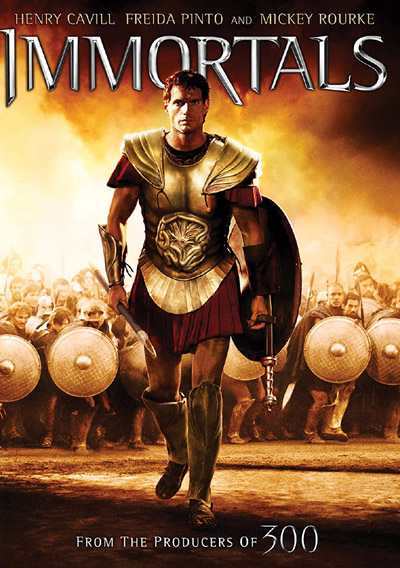
Mladen’s take
The film “Immortals” starts with a vision by a soon-to-be defrocked virgin oracle and ends with her glimpse of the future coming true. Between, the movie is filled with slick scenes of slaughter that only an R rating permits.
Immortals is loosely based on Greek mythology.
Gods, led by father Zeus and fearful of another internecine war with Titans, hope that a mortal becomes their savior. Theseus, portrayed by Henry Cavill, is nudged by fate and faith to fight against Hyperion, played by Mickey Rourke. Hyperion, a commander of vast legions, wants to free Titans to avenge cruelties that he and his family endured because Gods refused to intervene on their behalf. But, before Hyperion can achieve his desire, he has to fight Hellenes, and Theseus, defending the mountain where Titans are imprisoned.
As the heroes – Theseus and Gods – and antiheroes – Hyperion and Titans – edge closer to battle, Immortals tries to teach us lessons.
Theseus and his mother are peasants and abused by prominent members of the cliffside village where they live, so there’s a subtheme of class warfare.
Theseus, an unbeliever at the beginning of the movie, transforms into a man of faith. Hyperion, once a believer in Gods, scorns them. Guess which one survives the epic hand-to-hand combat at Immortal’s end? So, we are taught that those who bow to the will of Gods prevail and those who fail to genuflect, die. What crap.
Morals aren’t the strength of Immortals, but, I suppose, something had to be devised to bundle the movie’s virtue: gorgeous, stylized carnage.
Theseus sweeps through squads of Hyperion’s men with ballet-like precision, puncturing abdomens and heads with spears, slicing necks with swords, and, once, blasting them with electromagnetic arrows of the Epirus bow.
Though the peasant warrior’s magic with all objects sharp and pointy was impressive, nothing compared to the vivid gore that enveloped the screen when Gods or Titans warred. I’ll stop here to keep from spoiling the scenes, but wait until you see god Aries dispatch a half-dozen of Hyperion’s men in slow motion about halfway through the movie. The battle between Gods, who dress like sissies, and Titans, who look like corpuscular ash, is absolutely luscious.
Del and I saw Immortals in 3-D, though it isn’t necessary to enjoy the movie. The cinematography is bright enough, I suspect, to make Immortals very watchable in just plain 2-D, as long as the theater packs a good sound system.
Mladen Rudman is a former journalist and technical editor. Del Stone Jr. is a former journalist and author.

Image courtesy of Warner Brothers.
—
“Contagion.” Starring Gwyneth Paltrow, Matt Damon, Laurence Fishburne, John Hawkes, Jude Law, Marion Cotillard, Kate Winslet, Jennifer Ehle, Elliot Gould. Directed by Steven Soderbergh. 105 minutes. Rated PG-13.
Mladen’s take
Remember the best scene in the second-best movie made, “Jaws”?
Brody is ladling putrid chum into the Atlantic from the stern of charter boat Orca, when the massive white shark suddenly raises its head out of the water to look at him and then disappears as quickly and completely as it appeared.
The sheriff reflexively straightens, stiff with disbelief and fear, and says to the others aboard, “We need a bigger boat.”
Well, a similarly portentous scene unfolds between two pathologists early in the newly released film, “Contagion.”
The pathologists, one senior and the other his junior, open the skull of the dead character portrayed by Gwyneth Paltrow. As the junior pathologist pulls back the brain of the deceased, the senior medical examiner, stunned by what he sees, urges his cohort to step away from the table.
The more experienced pathologist tells the younger one that other health care professionals must be informed immediately about what they had uncovered.
“Who do I call?” asks the junior pathologist.
“Everybody,” responds the senior medical examiner. “Call everybody.”
“Contagion,” a story about a global pandemic that eventually wipes out 25 percent of humanity, is methodical. Grumpy Del would say plodding.
“Contagion” is about the way acts of selfishness or selflessness, profitmongering or altruism, panic or poise by individuals converge to create a collective reaction to a deadly virus. Del would say, “That’s boring. I want looting, gunfire, cannibalism, and other forms of grand-scale depravity.”
Alas, Del. What has become of you?
“Contagion” tackled the big questions. It just ignored some of the details.
And, the movie’s message is clear: We’re mostly on our own when a natural disaster strikes. The goal is to stay alive long enough for laws and social constraints to regain their hold.
As “Contagion” unfolds, we see a bitter blogger played by Jude Law use the Internet to market a snake oil that promises to cure those afflicted by MEV-1, a genetically simple, rapidly mutating monovalent virus. The blogger’s sales pitch includes government and corporation conspiracy theories with just enough facts to make them plausible.
A father, though he and his daughter are naturally immune to MEV-1, protects her with tenacity, but never uses violence. When a mobile Meals-Ready-To-Eat distribution center runs out of meals, others waiting in line break the cordon to storm the trucks. He protects a lady who’s attacked by another person because she had a box of MREs.
“Contagion” also notes failures in leadership. The American president flees to a hidey-hole for protection against the pandemic. By leading from the rear, his act of taxpayer-subsidized privilege contributes to the panic contorting the lives regular people.
Meanwhile, epidemiologists are working feverishly to develop a vaccine. One goes as far as using herself to test a vaccine that kept a MEV-1-infected monkey alive.
“Contagion” is filled with an all-star cast, but there’s no lead actor or actress. Though the movie shows the effect of the pandemic on well more than a dozen lives, its story is coherent.
“Contagion” is a good movie, maybe even a very good movie, but it’s not for action or blood-and-gore junkies such as Del.
Be patient, pay attention, recall what “SARS” stands for, and watch. You’ll know that you were affected by the movie if you exit the theater wondering how you’d protect your family from an unbiased – men, women, and children die – unseen organism and the chaos it unleashes.
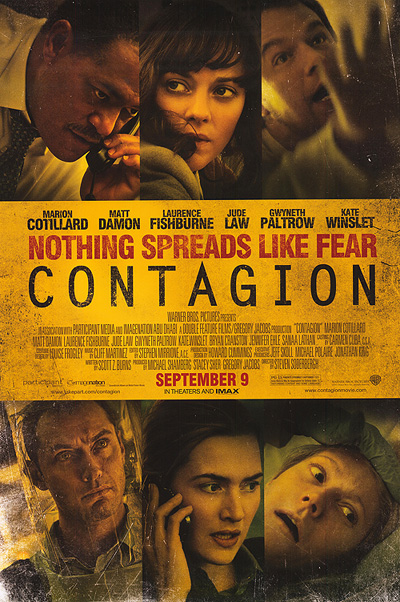
Del’s take
The problem with a guy who loved “Transformers” scolding a guy who wanted a little more action in his “action-thriller” is that Mladen didn’t actually see “Contagion.” About halfway through he fell asleep and dreamed it was a terrific movie.
Which is not to say “Contagion” is a bad movie. Rather, it isn’t the movie I was expecting. Billed as an action-thriller, “Contagion” comes across as a medical procedural about how to create a flu vaccine, leavened by low-grade attempts to humanize the story by giving us glimpses of ordinary people and how they react to a dangerous virus sweeping across the world.
“Contagion” is told through a series of vignettes involving multiple viewpoints – officials with the Centers for Disease Control (Fishburne, Winslet and Ehle), the World Health Organization (Cotillard), a so-called “journalist” (Law), a janitor (Hawkes), and an ordinary guy (Damon) whose philandering wife has unwittingly brought the disease to America.
Medical officials quickly recognize the disease’s lethal potential and try to act but, as usual, skeptical and blundering politicians slow their progress. Meanwhile, the disease spreads, social order begins to fray and a real breakdown of the processes that sustain our society seems imminent. Only a vaccine will prevent the collapse of civilization.
“Contagion” attacks not only our immune system but the institutions dear to our American hearts. Marriage is stricken with infidelity; the sanctity of our death rituals is sullied by mass graves, body bags and a ghoulish funeral director who refuses to handle disease-ravaged corpses; law and order gives way to looting, robbery and murder. Religion is ignored.
Oh, and there’s the Internet, which receives a well-deserved bashing. Jude Law plays the part of an online conspiracy theorist who believes the disease, MEV-1, is a money- and power-making plot engineered by a cabal of government and corporate entities bent on controlling our lives. He claims a natural remedy, not the government’s possibly autism-inducing vaccine, can defeat the virus. But it’s all a fraud … or is it? At one point Law is told by Dr. Ian Sussman (Gould): “You’re not a journalist. You’re a blogger,” and “Blogging is like graffiti with punctuation.”
Law turns in a powerful performance as irresponsible and disruptive blogger Alan Krumwiede. Also excellent are Fishburne as the CDC’s Dr. Ellis Cheever and Winslet as Dr. Erin Mears. Ehle turns in the best performance as Dr. Ally Hextall, who tests the vaccine on herself. Paltrow is her usual, giggly self, and Damon looks positively vampiric throughout, though he does get one good line. After a doctor tells him his wife has died, Damon’s character, Mitch Emhoff, not quite processing what he’s been told, responds with, “Right. But can I go talk to her?”
“Contagion” is strongest when addressing the medical aspect of the pandemic; it is weakest when dealing with the human component. Soderbergh’s austere direction and his focus on the clinical rather than the emotional render a sterile, dare I say boring treatise on disease, medicine and government. Based on the trailers I was expecting more – no, Mladen, not fires and explosions.
Maybe just a few people I could care about.
On a scale of 1 to 10 I would give “Contagion” a 7. Not a bad movie, but not the action-thriller I hoped to see.
Mladen Rudman is a former journalist and technical editor. Del Stone Jr. is a former journalist and author.
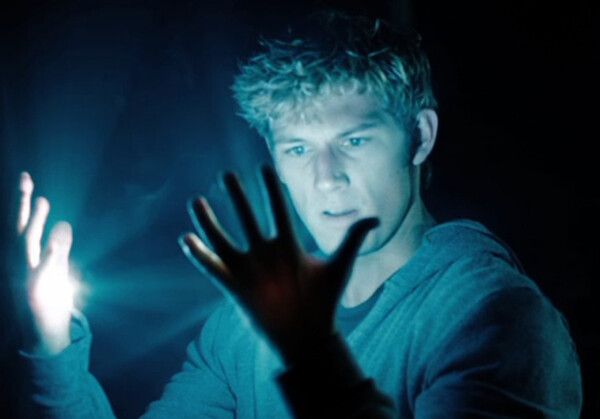
Image courtesy of Touchstone Studios.
—
“I Am Number Four” Starring Alex Pettyfer, Timothy Olyphant and Dianna Agron. Directed by D.J. Caruso. 109 minutes. Rated PG-13.
(Note: Mladen Rudman could not make the screening of “I Am Number Four.”)
Sadly, “I Am Number Four” is not much more than a steaming pile of number two.
Why?
The film suffers from an extreme case of schizophrenia coupled with an identity crisis. Is it a love story? Is it an action movie? Is it “Twilight”? Is it a summer movie?
It is all of these things and consequently none, which leaves “I Am Number Four” hanging in sequel limbo, possibly lost forever to producers Michael Bay and Steven Spielberg who, along with novelist James Frey (writing as Pittacus Lore, upon whose books the movie is based ) clearly aimed to produce the next superhero teen-angst franchise.
The plot is simple … or maybe not. A small group of alien refugees has come to Earth after evil Mogadorians ransacked their world and slaughtered their people. They’re hiding among us, hoping to blend in, as a Mogadorian hit squad roams the world, killing them in order ( hence the title “I Am Number Four” ). Numbers one through three have been eliminated. John ( Pettyfer ) is next. He and his protector, Henri ( Olyphant ) arrive at a small town in Ohio where John enrolls in the local high school. He meets and develops feelings for the retro-chic Sarah ( Agron ); clashes with Sarah’s ex, Mark ( Jake Abel ), who happens to be the high school football team’s quarterback AND the son of the local sheriff; and hooks up with the school nerd, Sam ( Callan McAuliffe ), whose dad mysteriously disappeared while tracking down evidence of extraterrestrials. As the pecking order is sorted out the Mog hit squad arrives, looking very Matrixesque. All hell breaks loose. As hell is resolved and the potential for a sequel clarified, Number Six ( Teresa Palmer ) shows up and lends a gun to the climatic battle.
Is “Number Four” a love story? Well, sort of. Lots of quality time and kissing between John and Sarah, and not a wisp of romance between John and Number Six ( though Sam seems smitten by the blonde bombshell ). Clearly the two have a thing for one another, and Sarah has renounced her relationship with Mark. But – and this is a big “but” ( warning, spoilers follow ) – at the end of the movie John leaves Sarah ( or at least appears to do so … something that could easily be fixed in the next film) and we’re left wondering just how dedicated these two are to each other.
Is “Number Four” an action movie? It is if you stick around for the second half. In the first 30 minutes it’s nothing more than a massive info-dump and scene-setting vehicle. We see Number Three die and John and Henri leave their Florida hideout for the anonymity of Small Town Ohio. We see John go to high school and endure the alleged rituals peculiar to that stage of a person’s life. We get voice-over background about the Mog’s destruction of John’s home planet. Pretty boring stuff. Along about mile marker 34 things get interesting as the Mogs show up and John discovers the true extent of his alien powers ( lightning speed, super strength and flashlight hands! ). Meanwhile we also learn Sam’s dad’s disappearance might have had something to do with the Mogs, which makes him a permanent member of John’s growing retinue, and Number Six is closing in to make sure John doesn’t die ( What the heck is Number Five doing? Playing Farmville? ).
Is “Number Four” “Twilight”? You better believe it. Same target audience, same plot. I wouldn’t be surprised if Sam turns out to be a werewolf.
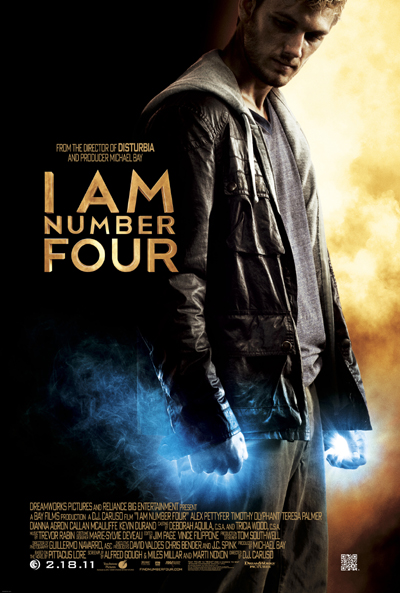
Lastly, is it a summer movie? Let’s put it this way: When the weather is cold I like to open a bottle of Redhook ESB, a hearty ale with a hefty bite that seems to keep the chills at bay. We’re talking “Winter’s Bone” or “The King’s Speech.” Come warmer weather, with its high heat and humidity, I switch to lighter, frothier fare, say a Corona Light. “Number Four” is definitely a Corona Light. It requires no thinking. So why was it released in February?
“I Am Number Four” is shot through with plot holes and logic flaws. No explanation is ever given for the Mogs inimical behavior, or why they must kill the refugees in order. John’s protector, Henri, is easily overcome and kidnapped by a couple of Ohio rednecks. Sarah’s picture-taking hobby seems peculiarly out of touch with the times as she uses ordinary film and develops her own prints. And only fleeting reference is made to why the Mogs must kill the alien refugees – apparently they’re capable of some great power, which begs the question: Why didn’t they use that power when their world was under attack?
Worse, “Number Four” is a cliché machine. Why must every new kid in high school fall in love with the ex-girlfriend of the football team quarterback who is the sheriff’s son? Why is the picked-on, shunned nerd really the smartest kid in school who has hidden strengths but doesn’t show them until a sexy protector arrives? Why must the viewpoint character discover his extraordinary powers while resisting school bullies? And why must every adult in the film be so clueless?
Acting was serviceable. Pettyfer is not a bad-looking fellow and Agron did as much with her role as she could. Better was McAuliffe, and my favorite character in the movie, the Mog commander, played by Kevin Durand, reveled in his evilness.
As of this writing “I Am Number Four” has made about $38 million at the box office. If it clears $100 million a sequel will probably be made.
Don’t hold your breath. The movie dropped 43 percent at the box office in its second week, which is a bad, bad sign. I expect it to top out in the $50 million to $60 million range.
“I Am Number Four” is, in my opinion, a Netflix movie. Save your ticket dollars for “Battle: Los Angeles.”
Del Stone Jr. is a former journalist and author.

Image courtesy of Warner Brothers.
—
“Harry Potter and the Deathly Hallows, Part 1” Starring Daniel Radcliff, Emma Watson, Rupert Grint. Directed by David Yates. 146 minutes. Rated PG-13.
Mladen’s take
The wizard in 1939’s “The Wizard of Oz” was a charming wussie.
The two wizards in 1981’s “Dragonslayer” were powerful servants of goodness.
The three principal wand-wavers in 2010’s “Harry Potter and the Deathly Hallows, Part 1,” are mopey and brooding, which must violate some kind of law of Wizard Conduct and Coolness.
The bad witch in Oz was shrill, menacing. Her flying monkeys to this day haunt children’s dreams. “Dragonslayer” offered a formidable and sentient dragon, which sought to protect its offspring and Vermithrax bloodline, as the creature to defeat. By the way, the book on which the movie is based is very good. The evil wizard in “HP and the DH” is as comically fierce as his name, Voldemort. Picture a pale green being with black teeth and gill slits for nostrils.
I somewhat enjoyed the first 90 minutes of “HP and the DH.” The remaining eternity was dull, barring a semi-touching death scene toward the end. I probably would have liked the second-to-last of the HP movies a pinch more had I brought a wizard’s dictionary, thesaurus, and voice translator to the theater. The cockney accent of the red-headed wizard played by Rupert Grint couldn’t be processed by my admittedly inadequate brain. Note to producers of “HP and the DH, Part 2”: Use subtitles whenever red-head speaks.
It makes sense, I suppose, that the HP movies have devolved from wistful to bleak as the principal wizards grew from children to adolescents. But, it was a substantial error to cloak the film’s special effects in grays. Even daylight was shot as though it was perpetual twilight in Potter’s lands. The result was loss of crucial detail that makes battle scenes plausible and thrilling or chilling.
Superb special effects, I suspect, would have been available in glorious brightness had “HP and the DH” moviemakers shifted some of the budget from rendering the movie too long to making it compelling. See “Starship Troopers” for an example of the way sunlit daytime reinforces a film’s plot and believability.
I don’t know. Maybe I’ll see “HP and the DH, Part 2” at a theater when it’s released later this year. I’m mildly interested in witnessing the outcome of Hermione’s, Harry’s, and Ron’s search for the horcruxes, medallions that give Voldemort his strength. I’m also mildly interested in seeing what havoc the Dark Lord causes now that he has the Elder wand.
Then again, who cares?
The first “HP and the DH” was disappointing and, I understand, the second was shot at the same time.

Del’s take
I’m not a “Harry Potter” fan, which is not to say I dislike “Harry Potter.” Though I haven’t read the books I did see the first four movies. I thought they were perfectly fine, even fun, entertainment.
I knew going into “Deathly Hallows Part 1” I’d have some catching up to do. Much had taken place in “Order of the Phoenix” and “Half-Blood Prince.” While I expected to wander the Hogwart world in confusion at first, I assumed the pieces would fill themselves in.
What I didn’t expect was to be bored.
In a nutshell, “Deathly Hallows” follows Harry, Hermoine and Ron as they cross the globe – or at least the UK – searching for the Horcruxes that will allow the evil Lord Voldemort to consolidate his hold over all things magic. They must destroy the Horcruxes, a feat they discover will be impossible without the Sword of Gryffindor. Along the way they scramble from subplot to subplot, escaping death by the hairs of Harry’s chinny-chin-chin.
People die, both good and evil. Battles rage. All things hang in the balance. And the movie ends with a cliffhanger – a perfectly adequate way of setting up the final chapter in the Potter saga, due in theaters this summer.
But in “Deathly Hallows” the magic vanishes. Not the wand-waving and incantations we’ve grown to know and like about the previous Potter movies. I’m talking about the innocence and the wonder of the Hogwarts universe, where children and evil trees and dragons co-exist, the world of possible anythings.
In “Deathly Hallows” wands become assault rifles and magic a banana clip. As Mladen noticed, the world is rendered in sad tones of gray. Relationships between characters take on the maroon shadows of a soap opera, all grim and unhappy and suspicious.
I agree with Mladen about Ron’s spoken lines – I could barely understand his mumbled Cockneyed accent. Hermoine’s perpetual foul mood diminished my sympathy for her. And Harry struck me as subtracted from the passion of events, as if he were preoccupied with an algabraic word problem.
I understand “Potter” author J.K. Rowling aged the characters from one book to the next, and darkened the plot in a similar fashion. Director Yates’ rendering of “Hallows” is true to the book. I don’t fault him for that.
But I think it’s a mistake to remove the one ingredient that made all the “Potter” movies so enjoyable – the fun. “Harry Potter and the Deathly Hallows, Part 1,” is no fun. It’s dark, moody and depressing – and way too long.
I might pass on Part 2, because as Mladen said, who cares?
Mladen Rudman is a former journalist and technical editor. Del Stone Jr. is a former journalist and author.

Monsters-movie-image
Image courtesy of Magnet.
—
“Monsters” Starring Scoot McNairy and Whitney Able. Directed by Gareth Edwards. 94 minutes. Rated R.
Del’s take
Late in the movie “Monsters” there comes a moment a literary book reviewer might call “luminous.” Ever notice how literary book reviewers always bring the word “luminous” into play, as if to excuse the lack of plot, the unfolding of dreary characterization and the trendy massacre of clearly wrought prose? You will never hear a Larry Bond novel called “luminous.”
This illuminating moment takes place when our two protagonists, Andrew (Scoot McNairy) and Samantha (Whitney Able), witness two 300-foot tall walking squids engage in making out, foreplay, maybe actual intercourse – with all the flailing tentacles, bioluminescent pulsing and noble whale song-like groaning it’s hard to tell what’s going on. Andrew and Samantha watch in awe as these two leviathans perform the vertical bop and you expect them to whisper, “Beautiful” as they gaze adoringly at each other.
I was whispering “Will somebody please BLOW THESE THINGS UP?”
To paraphrase my friend Kari: “Monsters” is what happens when an indie filmmaker, the cinema equivalent of a literary writer, tells himself, “We have nothing to fear but fear itself … and monsters.”
“Monsters” isn’t about monsters, that’s for sure. The monsters are metaphors for Andrew and Samantha, or illegal immigration, or existential angst. But it is more about the message getting lost in a stew of competing thematic imperatives.
The story goes like this: NASA discovers evidence of life elsewhere in our solar system and dispatches a probe to recover a sample. The probe crashes somewhere in Mexico and shortly thereafter weird creatures begin disrupting the flow of cocaine to America. Andrew, a jaded photojournalist, goes into the “infected zone” to document the mayhem. But he somehow becomes responsible for escorting his publisher’s daughter, who has been in the area, back to the States. They try by land, sea and air but due to a series of setbacks, mostly caused by their own stupidity, they fail and must travel directly through the infected zone to reach the gigantic wall America has constructed along its border with Mexico. Along the way Andrew, who has a kid but not a wife, and Samantha, who is to marry a fellow she doesn’t love, discover a growing affinity for each other. Can you guess how this is going to end?
I will give Edwards credit: “Monsters” is ambitious. It is not another “Godzilla,” “The Mist” or “Cloverfield.” What I didn’t like about it, however, was the plodding pace, the incompetence of the characters and their forced transformations, which did not encourage me to suspend my disbelief.
Characterization is shaky. We are expected to dislike Andrew at first because of his cynicism, then bond to him as he realizes there’s more to life than shooting a prize-winning photo. In reality Andrew is a scummy opportunist who shacks up with prostitutes when Samantha won’t sleep with him, something he pursues with such diligence that Samantha could have had him arrested for sexual harassment. And Samantha, as the poor little rich girl, is a cipher with no real purpose for existence other than serving as an object of desire for Andrew.
At every critical juncture in their journey they pause, undecided, then embark on some irrelevant and unrealistic conflict that jeopardizes their success. For instance, at one point they must get off a boat and travel overland under the watchful eye of armed guards – except Andrew doesn’t want to because the guards are carrying guns. Um, excuse me, but what part of “armed” did he not understand? And in a land occupied by 300 foot-tall squids who like to squash human beings, would you rather your guards be armed with Nerf Frisbees?
And once they reach the wall, well. It’s every Tea Partier’s dream, a cement monolith designed to keep out “illegal aliens.” Except the aliens, as we see in the scene I referenced above, are nothing more than noble, benighted creatures who want nothing more out of life than a brief interlude of happiness amidst an uncaring world. Except they are 300 feet tall and like to squash humans. I say, “Will somebody please BLOW THESE THINGS UP?”
“Monsters” is an interesting movie but it has problems. On a scale of A to F I would rate it a C+.

Mladen’s take
Let’s start with a list.
They’re 300-foot-tall walking octopi, or is it octopuses? Get your mollusks straight, Del.
They do get blown up, you savage, it’s just not witnessed, and,
“Monsters” the movie has one of loveliest, mournfully serene soundtracks ever pasted to celluloid.
For me, the best way to characterize “Monsters” is this: The movie is deeply satisfying, but superficially disappointing.
It took me about 20 minutes to realize that the film was unlike a Godzilla smashfest, “Cloverfield,” or “The Mist.”
After that, I shed the expectation of carnage and allowed the movie to chart its own course. The story is about man’s inhumanity to man and our reckless belief that we can corral nature.
Samantha and Andrew are likable tools used to teach us a lesson. They do a good job leading us through the Infected Zone, where the alien creatures have established a sanctuary after being brought to Earth by a NASA probe that crashed.
Once in the zone, the duo exists to draw attention to the look of civilization as it’s consumed by its own folly.
Vines overtake hotels built for tourists.
An F-15 emerges from the depths of a river, playfully pulled through the black water by one of the tentacled beasts. It never bothers Samantha, Andrew, or the crew of the longboat hired at an exploitative price to help get the Americans back to America.
When the couple finally reaches the U.S.-Mexico border, it discovers that the zigzagging walled fortress separating one country from the other has been abandoned. The aliens had breached its ramparts. The fight has come to the Homeland.
Agreed, there’s some hokey symbolism in “Monsters.” Del already gave examples, but you have to give the director of the film credit for trying to create something original.
“Monsters” is an artsy film with a liberal message, which ain’t gonna play too good in these parts.
Sit back and enjoy the film, paying attention to events and scenes framing the relationship between Samantha and Andrew because that’s the movie’s strength.
Mladen Rudman is a former journalist and technical editor. Del Stone Jr. is a former journalist and author.

Image courtesy of Columbia Pictures.
—
“2012” Starring John Cusack, Amanda Peet, Oliver Platt, Woody Harrelson and Danny Glover. Directed by Roland Emmerich. 158 minutes. Rated PG-13.
Mladen’s take
The film “2012,” now on DVD and Blu-ray disc, is a man-made disaster about a natural catastrophe.
“My gosh,” I said to myself about halfway through the longer than 2 1/2 hour movie, “can’t the world come to an end quicker?”
In “2012,” landmasses shift cataclysmically because mutant neutrinos from a solar flare superheat the Earth’s core. The Himalayas become the ocean’s flood plain. California becomes a part of the seafloor.
The upheaval results in hundreds of millions of deaths, unless you’re an Arab royal or Russian mobster who can afford to drop $1 billion euros per person for luxurious passage on secretly built “arks,” or happen to be a member of the Curtis family et al.
Ineptly, yet decisively, led by Jackson Curtis, as portrayed by John Cusack, the family ceaselessly eludes death by blunt trauma or scorching again and again and again and again.
The earth uplifts beneath their car, they escape.
Bridges collapse, they dodge.
The ground tears open at their feet, they scurry.
California explodes, they find an airplane to maneuver around toppling skyscrapers like a mosquito flying between raindrops.
A pyroclastic flow – ash spewing, acid sizzling, boulders flaming – comes gushing their way, but they outrun it.
Finally, don’t ask how, the Curtises reach the Himalayas, trudging through snow in search of the arks.
Just as they’re about to give up hope for the tenth time of surviving, along comes a Buddhist monk driving a pickup truck along a winding trail. He gives the Curtises a lift to a back entrance of the cavernous mountaintop shipyard where the monk’s brother, who helped build the arks, smuggles the whole lot aboard Ark 4, which belongs to America. What luck, eh?
The Curtises live and “2012” ends with three arks steaming for Africa, which apparently survived the churning core. Get it? Humans got their evolutionary start in Africa and now they’re returning to Africa for another beginning. “2012” teems with such philosophic wonderment and profound irony.
That the ships were called Arks, by the way, was the final straw for me.
I’m tired of sectarian references, in this case, ark as in Noah’s Ark, constantly appearing in catastrophe movies.
Why did “2012” director Roland Emmerich have to label the vessels that saved a small portion of corrupt, self-serving mankind, arks, as though the endeavor was noble?
It would have been more accurate to label the arks “survival ships for the filthy rich and slimy politicians.”
Or, the arks could have been called, “keep-the-privileged-alive semi-submersibles,” mimicking the DEA description of vessels drug traffickers use to move product along the coastlines of Central and South America.
Rent, do not buy, “2012” only if you have a potent surround sound system. The movie’s sound effects are its only merit.

Del’s take
Director Roland Emmerich blew up the White House in “Independence Day.” He knocked over the Statue of Liberty in “The Day After Tomorrow.” In “2012” he inundates, melts down and otherwise reduces to soggy molecules the entire world in an orgy of destruction that will leave you wondering what you did for entertainment before CGI made it possible to watch a tidal wave overwash the Himalayas.
If there is such a thing as “disaster porn,” “2012” is triple-X.
The storyline is simple: A freak burst of neutrinos from the sun is causing the earth’s core to heat up, resulting in an extinction-level event (to borrow a term from “Deep Impact”). Volcanoes the size of Wyoming will destroy vast swaths of countryside while earthquakes and tsunamis finish off what the volcanoes fail to vaporize.
The lead viewpoint character is John Cusack, a could-have-been writer who operates a limo service to pay the rent. He lives in a dump, oversleeps appointments and consistently lets down his ex-wife, Amanda Peet, and his two children. Peet has moved on to a new husband, a man with a solid job who provides her and the kids with a great house and lots of fun gadgets – not to mention contempt for Cusack’s fumbling inadequacies as a father and a man.
See where this is going?
Meanwhile strange events are unfolding around the world. Earthquakes open cracks along fault lines in California. Lakes boil away in Yellowstone Park. The church channel lady with the pink cotton candy hair shaves her head and gets a nose bob … OK, maybe that’s a little too weird but you get the picture.
What follows is a hair-raising series of improbable cliffhangers resulting in … well, let’s just say if you’re familiar with the Roland Emmerich formula you’ll not be disappointed.
“2012” is silly and stupid, but it’s also a lot of fun.
The science is non-existent. Take those pesky neutrinos. Neutrinos have no mass, which means they pass right through you and me, the buildings we inhabit, and the earth itself. How can something that has no mass heat the earth’s core?
In the movie we see a huge Russian transport airplane, an Antonov 225, perform a 60-degree power climb. Ain’t happening folks, not even with a crazy Russian hotdog of a pilot.
And “2012” seems to forget all about the nuclear winter hypothesis, which predicts that if you inject enough soot and dust into the atmosphere, the sun isn’t going to shine for months if not years.
I’m curious. Why do these disaster movies never take into account the hundreds of wrecked nuclear reactors around the world? All that plutonium has got to go somewhere.
And why does every disaster movie center around a divorced dad trying to win back the love of his children, if not his ex-wife? John Cusack’s role seems lifted directly from Steven Spielberg’s “The War of the Worlds” Tom Cruise character. Or “Independence Day.” Or even “The Day the Earth Stood Still.”
I guess we’re supposed to ignore those logic flaws as we watch an aircraft carrier of a surfboard take out the White House, or the San Andreas fault submerge the entire West Coast into the Pacific.
I can do that for two hours.
When “2012” debuted on DVD it blew away the competition. I had to ask the folks at the local Blockbuster if they had a copy behind the counter because the shelves were empty. As I waited, two more customers asked for it. (Speaking of which, don’t you hate the demise of the local DVD rental store? Netflix, Red Box and streaming are lousy substitutes for wandering the aisles as you check out the dust jackets on a DVD case.)
I give “2012” 3½ out of five stars, subtracting points for bad science and hackneyed storytelling, but awarding points for special effects and entertainment value.
Your $5 rental fee won’t have been wasted.
Mladen Rudman is a former journalist and technical editor. Del Stone Jr. is a former journalist and author.
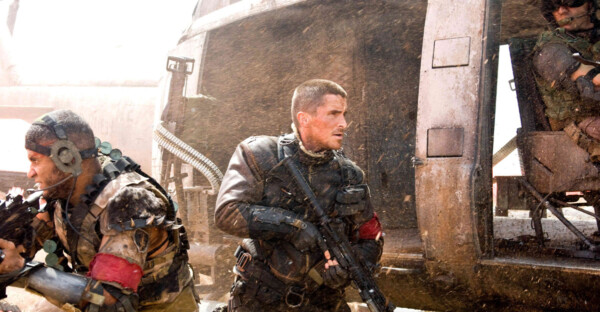
Image courtesy of Warner Brothers.
—
“Terminator Salvation” Starring Christian Bale, Sam Worthington, Anton Yelchin, Moon Bloodgood. Directed by McG. 114 minutes. Rated PG-13.
Mladen’s take
Take a little “Total Recall,” mix it with “Transformers,” sprinkle a tablespoon of “Mad Max,” bake at 350 degrees computer-generated special effects, and, voila, the result is “Terminator Salvation.”
“Salvation” is unable to compete with any of its three predecessors but it ain’t a bad film. One weakness is its PG-13 rating. There are plenty of explosions, but no close ups of bullets or shrapnel shredding bodies, or robo-hands tearing off heads.
The principal difference between “Salvation” and the other Terminator movies is that John Connor, humanity’s salvation, is now an adult and Kyle Reese, Connor’s father, is a child. Nevermind, it’s not worth explaining.
In the first three movies, the objective is to keep Connor alive. In the fourth, it’s making sure Reese avoids ingesting 40 7.67-mm rounds per second from a minigun.
Christian Bale, as Connor, plays what has now become a potentially career-ending typecast for him, a brooding, mopey hero.
The most interesting character in “Salvation” is the machine army’s first T-800 cybrid assassinator, which is unaware of its origin or allegiance. Sam Worthington portrays the cybrid, known as Marcus Wright.
Once you overlook the murkily explained way Wright becomes the next-generation terminator, his portrayal of a sentient machine enduring an identity crisis is fairly convincing.
Add to Worthington’s character the lovely and very human sidekick, A-10 pilot Blair Williams, and “Salvation” becomes more than palatable. Williams is played by Moon Bloodgood, a beautiful woman with the sexiest voice on the planet.
Typical of Armageddon-like movies, the post-apocalypse Earth in “Salvation” is drab browns, dark blues and assorted grays. Only flashing red lights and the orange of explosions adds color to the film.
It takes some suspension of contextual logic to consider mankind’s resistance against the encroaching world of a computer constellation with artificial intelligence plausible.
For example, if Skynet, the Vladimir Putin of the machinekind in “Salvation,” is so smart, lethal, and efficient, why did it fail to nuke all of America’s military bases and repair depots? I ask because the humans in the film have access to a broad range of weapons. From MV-22s to a nuclear-powered attack submarine, Connor and his troops avoid the uncomfortable position of fighting robots with clubs and rocks.
“Salvation” gets three stars out of five, if for no other reason than its respectful bow toward the end to the greatest terminator of all, the now politically besieged governor of California.
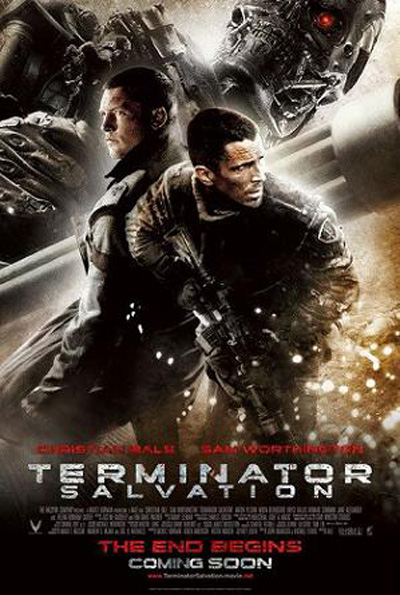
Del’s take
Let’s see if I can nail down the premise of “Terminator Salvage Operation”: John Connor must jack into the Matrix where his mentor Obi Wan has been captured by an alien face-hugger. There he meets Gandolf, who wields a mean club when the Road Warrior attacks, but they escape with the aid of Mr. Spock who is undergoing the colon-cleansing ritual of pon-fart.
I swear. There were times during “Terminator Salvation” when I thought I was watching “The Road Warrior,” “Transformers” and maybe just a wee bit of “Star Trek,” “Alien” and “Lord of the Rings.”
These science fiction franchises have become about as interesting and fun as a civil service employment application. They’re way too complicated and take themselves way too seriously, and their creators seem to have forgotten that story will always trump effects.
Worse, they’re all borrowing stuff from each other, sort of like a taco pizza cheeseburger.
Here’s the rundown on “Salvation”: It occurs after “Judgment Day,” the day a vast computer system called Skynet becomes self-aware and decides to pan-roast humanity with the nuclear bombs it has been put in charge of (and this date conveniently shifts from movie to movie. In the original “Terminator” it was Aug. 29, 1997. In “Terminator 2: Judgment Day” it’s July 25, 2004, presumably because of meddling in the timeline. In the TV show “Terminator: The Sarah Connor Chronicles” it’s moved to April 2011 … can’t they just settle on a date and be done with it?).
After pushing the button Skynet decides to rid the world of pesky human survivors by building a global network of machines that work 24/7 to hunt down human beings and kill them. Humanity, deprived of its Netflix popups and angry because of it, retaliates by organizing resistance fighters who live underground, eat rats, and have access to phase plasma rifles in the 40-watt range (an homage … get it?).
John Connor, the anointed savior of mankind, must make sure his dad, the teenaged Kyle Reese, lives long enough to go back in time and impregnate his mother, Sarah Connor. Meanwhile the first human-like Terminator awakens and thinks he is human, never believing he might have been programmed to do what he spends most of the movie doing. Amazingly he bumps into Reese, one of two survivors living in Los Angeles, and then the movie becomes one big fist punching, guns blazing, jets screaming, atomic-bomb exploding craptravaganza.
I was wrong. This isn’t a civil service employment application; it’s Donald Trump’s tax return.
Christian Bale becomes tiresome as the eternally brooding, always angry John Connor. I keep remembering that insane tirade (warning: extremely foul language) by Bale posted on the Internet where he threatened to beat the &@$% out of the director of lighting for interrupting his shot. Moon Bloodgood irritates me because her name is so obviously contrived. And how did Anton Yelchin (“Star Trek”) score two of the biggest movies of the summer season?
One bright note is Sam Worthington as the Terminator who doesn’t know he’s a Terminator. Oops! Spoiler? No problema, baby. It’s telegraphed in the first five minutes.
I have two regrets about “Terminator Salvation.”
No. 1: There was no “Battlestar Galactica” tie-in.
No. 2: I spent $7 seeing this in the theater when I could have waited for it to show up in the $5 bin at Walmart.
From what I hear there’s a T5 in the making.
I guess the Terminator will be back.
Mladen Rudman is a former journalist and technical editor. Del Stone Jr. is a former journalist and author.
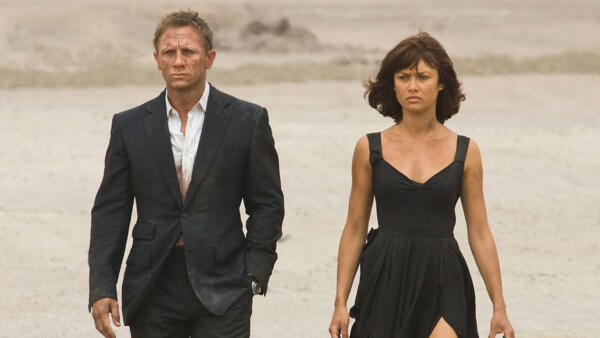
James Bond (DANIEL CRAIG) and Camille (OLGA KURYLENKO) walk through the Bolivian desert. Location: Chile
Image courtesy of MGM.
—
“Quantum of Solace” Starring Daniel Craig, Olga Kurylenko, Mathieu Amalric and Judi Dench. Directed by Marc Forster. 106 minutes. Rated PG-13.
Del’s take
Don’t ask a James Bond purist what he thinks of “Quantum of Solace.” He’ll likely curl his lip, let out an exasperated huff and mutter something to the effect, “They’ve ruined 007!”
And well they might. Like many fictional characters who have made the transition from 20th century escapism to 21st century realism, Bond has been transformed. “Quantum of Solace” continues that evolution.
(Warning: Spoilers follow.)
The plot is classic 007. A super-secret organization known only as Quantum angles to depose the current Bolivian government and replace it with a strongman willing to sign over that country’s most precious resource – water. Give the screenwriters credit: They anticipate the ferocious competition predicted by climatologists to result from global warming and its diminishment of potable water supplies.
Despite orders to the contrary from the redoubtable M (Judi Dench), Bond (Daniel Craig) travels to South America to discover exactly why it is ersatz environmentalist Dominic Greene (Mathieu Amalric) has taken such an interest in an apparently barren desert. Vengeance is a subplot. Bond seeks payback for the death of Vesper Lynd while Bond’s female counterpart, a Bolivian secret service agent, Camille (Olga Kurylenko) aims to kill the appointed strongman who murdered her parents.
The action is hyperkinetic and at times almost unwatchable as exquisitely choreographed fight scenes unfold at a blistering pace, leaving Bond a dirty, bloody shambles who nevertheless prevails over the bad guy de jour.

Almost lost amid Craig’s intensity is the humor – not the campy double entendres of Roger Moore’s Bond or the sly sophistication of a Sean Connery, but actual comedy that launches unexpectedly from the darkness. Upon arriving in Bolivia, Bond is escorted by a sexy British agent to a seedy hotel where they will pose as exchange teachers. Unhappy with the accommodations, Bond takes them to the ritziest hotel in town where he explains to the desk clerk, “We are exchange teachers – and we just won the lottery.”
But much goes missing in “Quantum of Solace,” and this is where purists will hold their noses. Lost is the suave, indefatigable James Bond who emerges from a wet suit wearing a tuxedo, his hair unmussed. Gone are the insane luxuries of the super-rich, the creatively dysfunctional devices of murder (death by laser emasculation) , and the over-the-top malevolence of the ultra-evil.
Worse, we see Bond bleed, and that is not part of the Sean Connery canon of an unreachable and untouchable super man. It is as if Bond has also been tainted by the economic meltdown and would trade his beloved martinis for a can of Miller Lite.
This new Bond is more Serpico than, well, James Bond, and while that may satisfy critics one must wonder if the paying public will believe its escapist dollars have been well spent. So far box office receipts have been excellent so it’s hard to argue with numbers.
Ultimately you must ask yourself: Why do people go to movies? If it is to see a reasonable facsimile of yourself then the new, evolved James Bond may work.
But if it is to see a spectacle that rises above the gritty ordinariness of life, expect a regime change in the James Bond pantheon of superheroes.
Del Stone Jr. is a former journalist and author.
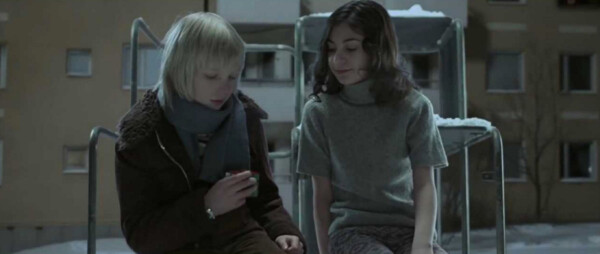
Image courtesy of EFTI, Sveriges Television and Filmpool Nord.
—
“Let the Right One In” Starring Kare Hedebrant, Lena Leandersson, Per Ragnar, Karen Bergquist. Directed by Tomas Alfredson. 115 minutes. Rated R.
Del’s take
You’re a 12-year-old boy and the bullies at school are eating your lunch. Wouldn’t it be nice if you could invoke the powers of your vampire girlfriend for a bloody session of attitude adjustment?
That’s the premise of “Let the Right One In,” a Swedish vampire flick that eerily and effectively reminds us that love comes along when it’s least expected, and from the unlikeliest of angles.
Oskar (Kare Hedebrant) is a pale, frail wisp of a boy who receives the unwanted attentions of a trio of bad boys at his school in the Stockholm suburb of Blackeberg. He fantasizes about revenge, sticking a knife into a tree and clipping newspaper articles about murders.
His home life isn’t much better. His parents are divorced. His alcoholic father lives in the country with a male friend while his mother works full-time and comes through the front door frazzled and worried. He spends much of his time at his apartment complex’s playground, dreaming of the escape he will never make happen.
He meets Eli (Lena Leandersson), the strange girl who has moved into the unit next door. She only comes out at night and seems impervious to the Swedish cold. Despite her pronouncement that she doesn’t want to be friends the two are drawn to each other, perhaps by their mutual strangeness.
Soon, bizarre murders haunt the streets of Blackeberg and Oskar, with Eli’s encouragement, stands up to his tormentors – the results are tragic. Still, “Let the Right One In” provides an option for hope.
But its most powerful virtue is the subtle elegance of its storytelling. “Let the Right One In” is flecked with moments of brutality, as any good 21st century vampire story must be. But it is also a serene journey through quiet, nighttime snowfalls, the unremitting gray of winter and the inevitable slide into dissolution that in this case is tempered by a weird redemption.
American audiences will not like the subtitles but never fear, in the tradition of “The Ring” and “The Grudge,” an Americanized version is due out this year.
“Let the Right One In” is not a movie for children or adults with timid constitutions. For everyone else it is a strange poem that will leave an uneasy impression that like water – or blood – love finds a way into the hardest of hearts.
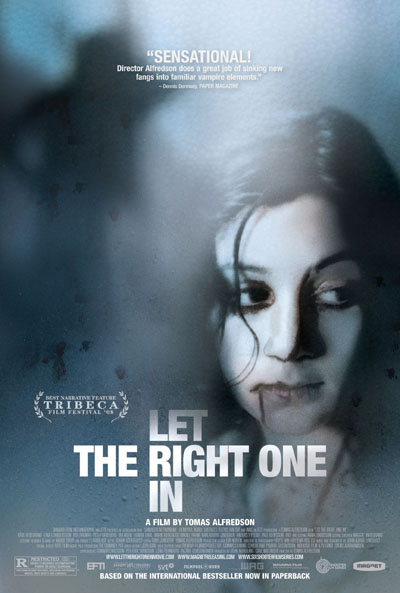
Mladen’s take
It’s clear by watching “Let the Right One In” that a vampire-friend would be useful if you’re the victim of bullies in middle school. Any middle school. Even a middle school in Sweden, where this very good, intermittently troubling film was made.
Before proceeding, let me stress that the penultimate scene in “Let the Right One In” offers one the finest pieces of cinematic slaughter ever created. Like much of the rest of the movie, its director, Tomas Alfredson, filmed the segment sparingly but punctuated it with bits of vivid dismemberment. The soundless incident was mesmerizing, not ghastly, though the victims were a couple of pre-teenagers and one adolescent.
“Let the Right One In” defies Hollywood-homogenized vampire film plots. It isn’t a sappy romance such as “Twilight” or a bloodletting similar to “30 Days of Night.”
It’s a movie about friendship, exploring the nature of honesty, loyalty, and trust. The protagonists are 12 years old but their struggles resonate with what we face as adults.
In one scene the dark-haired vampire cutie Eli accepts Oskar’s unvoiced gesture to enter his home, though he knows she must be invited verbally. Eli willingly placed her life in his hands by crossing the threshold and endured near-disintegration before he blurted “Come in” to end the horror.
Friendships have a darker side, too.
There’s the matter of making choices that close doors leading to other forms of happiness. There’s the urge to reciprocate. And, we inevitably become a little like the people considered friends.
Eli, shortly after the threshold incident, pounces on Oskar. She urges him too become more like her, something that, in fact, had been happening since the two met. Pay attention. At this moment and a couple of others, Eli’s young, creaseless face transforms, betraying the true age of her worn soul.
The movie ends with the impression that Eli had become more mankind-like and Oskar, more vampire-like, but both were human. Each of the two beings, it seems, had let the right one in.
Mladen Rudman is a former journalist and technical editor. Del Stone Jr. is a former journalist and author.

Image courtesy of Marvel Studios.
—
“Iron Man” Directed by Jon Favreau. Starring Robert Downey Jr., Jeff Bridges, Terence Howard and Gwyneth Paltrow. 126 minutes. Rated PG-13
Mladen’s take
Here’s a viewer’s guide to “Iron Man,” the blockbuster movie: DO NOT pay attention to details but DO stop thinking about the film the moment it ends.
“Iron Man” is light, entertaining fare suitable for matinee viewing.
Below is the partial list of flaws. Remember, the devil is in the details. Details are important to me if I’m going to swallow the director’s effort to make Iron Man a plausible do-gooder by setting him in the real world.
— Why would the planet’s premier weapons maker and billionaire playboy Tony Stark — Iron Man-to-be — go to Afghanistan to personally demonstrate a surface-to-surface artillery missile, an Army weapon, to a bunch of guys in the Air Force. Stark’s 19-billion-square-foot concrete mansion and adjoining property consume much of the western seaboard, so they must border the White Sands Missile Range. Wouldn’t it have been easier to test fire the Jericho missile there?
— If Stark, played by Robert Downey Jr., is the world’s premiere weapons designer and all-around genius, why does he use flares to try to defeat a radar-guided air-to-air missile fired at him while he’s in Iron Man mode? Shouldn’t he have dispensed chaff?
— Pepper Potts, Stark’s personal assistant, is played by breathtaking Gwyneth Paltrow. Why would it take womanizer Stark years to recognize her beauty and smarts and make a play for her. The romantic tension is the movie’s only awkward part.
— Why is an active-duty airman, a lieutenant colonel played by Terence Howard, attached to Stark as he roams the globe? The half-colonel also is one of Stark’s spokesmen.
— Why did Del automatically get a senior citizen discount from the elementary-school looking youngster in the ticket booth though he’s far from being a senior. I paid $2.50 more than Del to see “Iron Man,” a fact still stuck in my craw.
No question, “Iron Man” is over-hyped. It lacks the zest of the last truly iconic blockbuster released, “Jaws.” But, as long as you don’t pay full price for the ticket, the metal homo sapiens will keep you pleasantly distracted for some two hours.

Del’s take
If it’s any consolation, Mladen, that senior citizen’s discount is stuck in my craw too. But $2.50 is half a gallon of gasoline and geezers like me need that gas to drive to all those cheap buffets around town.
And I wouldn’t say “Jaws” is the last iconic blockbuster. “E.T.,” “Aliens,” “Terminator 2” and “Titanic” all fit that category, to name a few.
But I agree. “Iron Man” doesn’t live up to the hype. It’s a decent enough movie … NOT another “Cloverfield” or “Dawn of the Dead,” which is the best movie ever made.
“Iron Man” is about a weapons developer who travels to Afghanistan and sees firsthand the horrors his products have inflicted on the innocent. He’s captured by terrorists, who force him to build a diabolical weapon for their nefarious use.
Instead, he builds a crude Iron Man exo-suit and uses it to escape his captors. Once back in the States he fabricates a superior version of the suit and vows to put the terrorists out of business permanently.
It’s all silly fun as Iron Man dodges jet fighters and decimates evil mujahideen while defying the physical laws of the universe. The movie requires a Herculean suspension of belief – science is non-existent as Iron Man flies from California to Afghanistan on a single tank of gas, plummets into the ground at hundreds of miles per hour only to arise unhurt, and crashes through the roof of his mansion to crush a sports car … try doing that in a Kia and see how far you get on your senior citizen’s discount.
Forget Robert Downey Jr. The real star of “Iron Man” is Jeff Bridges, who perfectly embodies the suave, lizard-tongued CEO of Stark Industries out to make a buck at the expense of friend, family and nation.
I think “Iron Man” is a good rental movie, not one to see in theaters – unless you’re getting in for $2.50 less than Mladen.
Mladen Rudman is a former journalist and technical editor. Del Stone Jr. is a journalist and author.